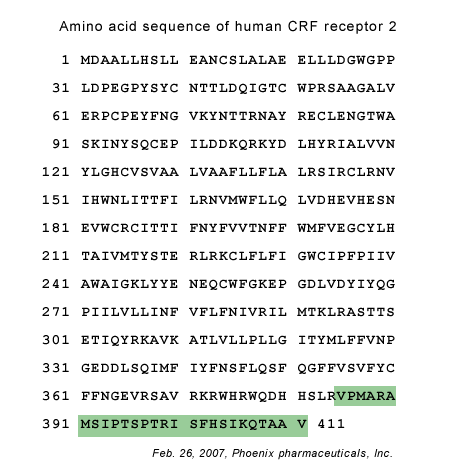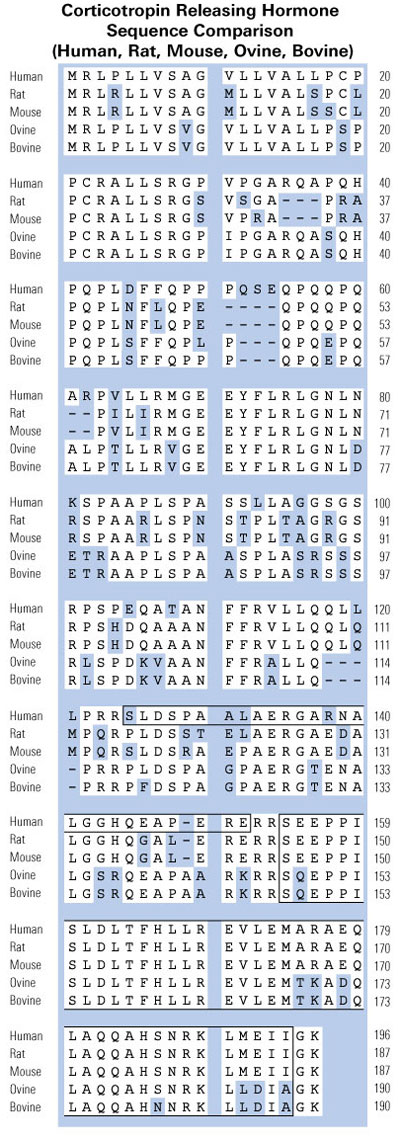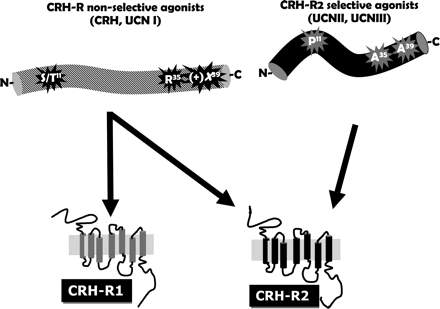Catalog # |
Size |
Price |
|
|---|---|---|---|
| MB-019-06 | 1 ml | $796 |

 |
 |
The corticotropin-releasing factor (CRF) system could play a significant role in the regulation of energy balance. This system, which includes CRF, CRF-related peptides and CRF receptors, is part of a huge network of cells connected to central and peripheral pathways modulating energy metabolism. CRF and CRF-related peptides, which elicit their effects through G-protein-coupled receptors known in mammals as CRF(1) receptor and CRF(2) receptor, are capable of strong anorectic and thermogenic effects. Also supporting a role for the CRF system in the regulation of energy balance are findings demonstrating alterations in this system in obese and food-deprived animals that concur to facilitate energy deposition. In recent years, great progress has been made in understanding the specific physiological roles of the CRF system. In that respect, the discovery of urocortins II and III, two endogenous ligands of the CRF(2) receptor, and the development of selective and long-acting antagonists for the CRF receptors, have led to a better comprehension of the role of the CRF system in the regulation of energy balance. Although there are still important unresolved issues in the field of CRF research, the progress made recently warrants investigations aimed at evaluating the CRF system as a potential target for anti-obesity drugs.
Richard D, Lin Q, Timofeeva E. The corticotropin-releasing factor family of peptides and CRF receptors: their roles in the regulation of energy balance. Eur J Pharmacol. 2002;440(2-3):189-97
Corticotropin-releasing factor (CRF), urocortin and urotensin I share amino acid sequences, and they inhibit food intake in mammals. CRF plays a potent role in decreasing food intake in avian species, but the effects of urocortin and urotensin I have not been investigated. Therefore, the effect of these three peptides on food intake in the neonatal chick was compared. In Experiment 1, birds were injected intracerebroventricularly (i.c.v.) with either 0, 0.01, 0.1 or 1 microg of urocortin following a 3-h fast, and food intake was measured for 2 h post-injection. Food intake was suppressed in a dose-dependent manner. Using a similar design in Experiment 2, the effect of urotensin I was investigated. Urotensin I appeared to suppress food intake in neonatal chicks more than urocortin did. In Experiment 3, the efficacy of CRF, urocortin and urotensin I was directly compared using one dose, 0.1 microg. The results indicated that the suppressive effect on food intake was strongest for CRF followed by urotensin I, then urocortin. These results suggest that the structure of receptors for the CRF family in chicks may be somewhat different than in mammals.
Zhang R, Nakanishi T, Ohgushi A, et al. Suppression of food intake induced by corticotropin-releasing factor family in neonatal chicks. Eur J Pharmacol. 2001;427(1):37-41
The view that energy balance is regulated has gained acceptance in recent years. An important role in this regulation is played by brain circuitries involved in the control of energy intake (food intake) and energy expenditure (thermogenesis) that are capable of integrating peripheral signals, produced by perturbations of adipose tissue mass, into messages to effectors of food intake and energy expenditure, so as to prevent substantial variations in the level of energy reserves. More than one neurosystem has been reported to genuinely participate in the regulation of energy balance. Among them is the corticotropin-releasing hormone (CRH) system. This system, with its numerous clusters of brain neurons, its closely related peptide urocortin, its two receptor types and its binding protein, all generally widely distributed throughout the brain, forms a network of neuronal pathways capable of interacting with the circuitries controlling food intake and energy expenditure. In addition, CRH and urocortin's anorectic and thermogenic actions appear to be coordinated to optimize energy losses. Finally, the CRH system seems to demonstrate a certain degree of plasticity in obesity and in response to food deprivation that is consistent with its action on food intake and thermogenesis. The observations have been made that food deprivation and obesity can blunt the expression of the CRH type 2alpha receptor in the ventromedial hypothalamic nucleus and can induce the expression of the CRH-binding protein (a CRH-inactivating protein) in brain areas involved in the anorectic and thermogenic actions of CRH.
Richard D, Huang Q, Timofeeva E. The corticotropin-releasing hormone system in the regulation of energy balance in obesity. Int J Obes Relat Metab Disord. 2000;24 Suppl 2:S36-9

No References
| Catalog# | Product | Size | Price | Buy Now |
|---|
Social Network Confirmation